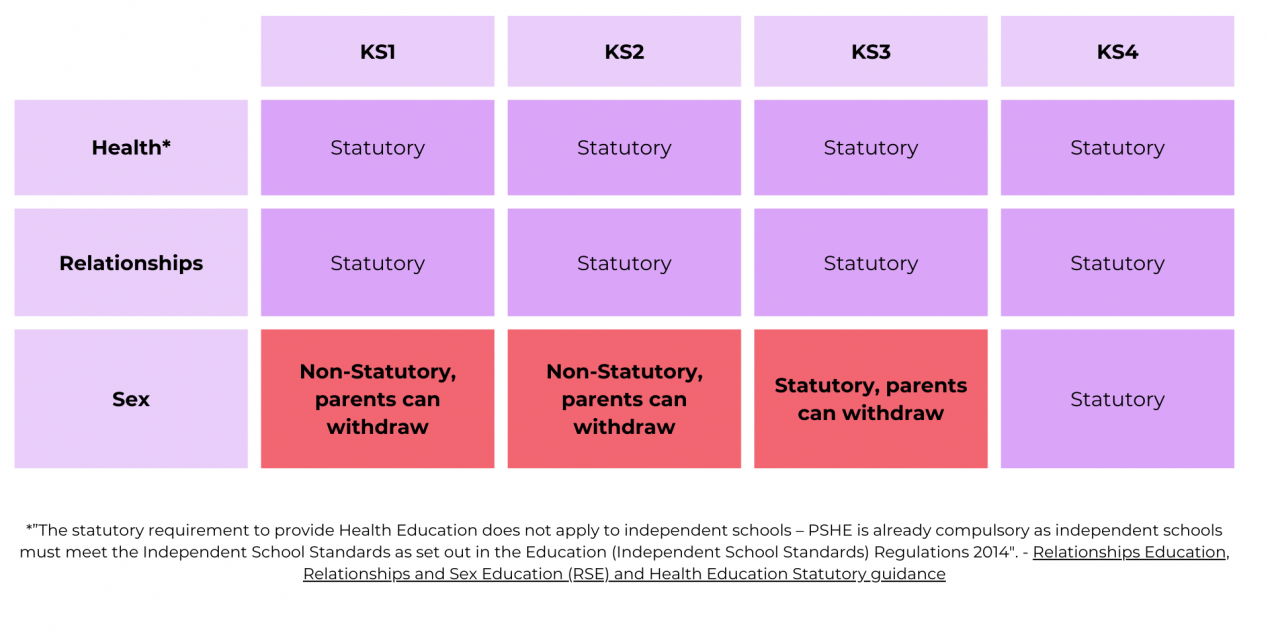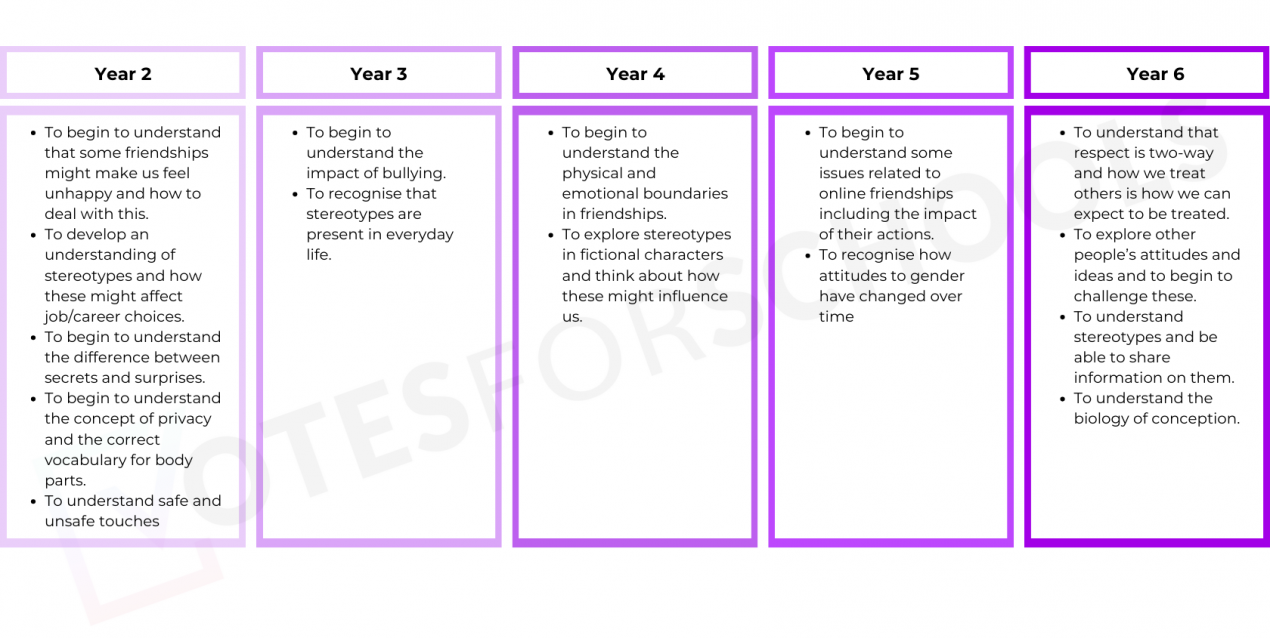Relationships, Health & Sex Education (RSHE) was put in place in schools in September 2020 (after being introduced in June 2020). It is a statutory part of the National Curriculum, meaning it must be taught.
You may also see it referred to as Relationships & Health Education (RHE) or Relationships & Sex Education (RSE). This is because the guidance can be split into three broad topic areas: Relationships, Health and Sex. Click or hover over each image for more information:
The fundamental building blocks and characteristics of positive relationships (primary) to know what a healthy relationship looks like and what makes a good friend, colleague or any type of committed relationship (secondary).
The characteristics of good physical health and mental wellbeing (primary) and a focus on enabling pupils to make well-informed, positive choices for themselves (secondary).
Knowledge about safer sex and sexual health to ensure that young people are equipped to make safe, informed and healthy choices as they progress through adult life (secondary).
In Primary Schools, Relationships and Health Education (RHE) is mandatory. In Secondary schools, pupils are also taught Sex Education.
.
.
To give you a quick overview of the lessons taught within RHE & RSHE, we’ve put together these tables. Primary school sets the foundations of knowledge regarding RSE, which is built upon in Secondary school:
| Relationships | Health | ||
|---|---|---|---|
| Healthy Lifestyle Choices including sleep, diet and exercise. | The importance of family, and how families can be different. | ||
| The importance of stable, caring relationships | That we sometimes get ill and may use medicines to treat illness. | ||
| What healthy friendships look and feel like | Mental Health including feelings changing & dealing with emotions. | ||
| Permission seeking and setting boundaries | Change & Loss | ||
| Appropriate and inappropriate or unsafe contact. |
| Relationships & Sex | Health | ||
|---|---|---|---|
| Consent | The impact of puberty | ||
| Sexual Exploitation, Online Abuse, Grooming & Coercion | That viewing sexually explicit content can damage the way people see themselves | ||
| Harrassment, Rape and Domestic Abuse. | The impact of viewing harmful content | ||
| Forced marriage, Honour-based Violence and FGM | Mental health, including recognising and managing wellbeing issues as well as how to seek support. | ||
| The facts and the law about sex, sexuality, sexual health and gender identity. | |||
| Stable and healthy relationships and same sex relationships. |
.
The first thing for educators and parents/carers to know is that Relationships & Health Education are statutory for all pupils meaning schools must teach these topics. Sex Education is only statutory for Secondary school aged pupils; however, this is not to be confused with reproductive science, which is statutory in primary schools.

While Sex Education is not statutory in Primary schools, the Government does recommend that all primary schools teach elements of Sex education. The curriculum states, “all primary schools should have a sex education programme tailored to the age and the physical and emotional maturity of the pupils. It should ensure that both boys and girls are prepared for the changes that adolescence brings and – drawing on knowledge of the human life cycle set out in the national curriculum for science - how a baby is conceived and born.”
.
Some Primary schools may also choose to teach other elements of Sex Education where appropriate. This will depend on the needs of their pupils, and will always be reviewed by Ofsted during an inspection.
.
The two other important points for educators and parents to know are:
all RSHE curriculum materials should be shared with parents/carers upon request
parents can withdraw their children from Sex Education up until the age of 15, but not from Relationships or Health Education.
.
The biological aspect of reproduction will always be taught in science lessons in Primary schools, usually in Year 5 or 6. Parents/carers cannot withdraw children from these lessons. This includes learning about the life cycle of different animals and plants, how children grow from babies to adults and the changes that happen within their bodies, including pregnancy and birth.
.
In addition to the biological aspects of sex, there are also other examples of overlap. The table below shows the statutory requirements of the Science curriculum that are closely linked with RSE:
| Year Group | Science Programme of Study – Statutory requirements | Science Programme of Study – Non statutory notes and Guidance | Vocabulary |
|---|---|---|---|
| Year 1 | Identify, name, draw and label the basic parts of the human body and say which part of the body is associated with each sense. | Pupils should have plenty of opportunities to learn the names of the main body parts (including head, neck, arms, elbows, legs, knees, face, ears, eyes, hair, mouth, teeth) through games, actions, songs and rhymes. | head, neck, arms, elbows, legs, knees, face, ears, eyes, hair, mouth, teeth, penis, testicles, vulva |
| Year 2 | Notice that animals, including humans, have offspring which grow into adults Describe the importance for humans of exercise, eating the right amounts of different types of food, and hygiene. | They should also be introduced to the process of reproduction and growth in animals. The focus at this stage should be on helping pupils to recognise growth; they should not be expected to understand how reproduction occurs. The following examples might be used: egg, chick, chicken; egg, caterpillar, pupa, butterfly; spawn, tadpole, frog; lamb, sheep. Growing into adults can include reference to baby, toddler, child, teenager and adult. | baby, toddler, child, teenager, adult |
| Year 3 | Children should understand that pollination is the movement of pollen from one flower to another and that a seed is formed when material in the pollen joins with material in the ovule | Pollination, pollen, male, ovule, female, seed | |
| Year 5 | Pupils should be taught to: describe the changes as humans develop to old age | Pupils should draw a timeline to indicate changes in the growth and development of humans. They should learn about the changes experienced in puberty. | gestation period, pregnancy, live birth sexual reproduction, sperm, ovum, internal fertilisation, external fertilisation, egg, live birth, gestation period |
| Pupils should be taught to: describe the differences in the life cycles of a mammal, an amphibian, an insect and a bird describe the life processes of reproduction in some plants and animals | Pupils should find out about different types of reproduction, including sexual and asexual reproduction in plants, and sexual reproduction in animals |
.
With the curriculum covered, a common question asked by parents & teachers alike is whether parents can opt out of RHE in Primary Schools, and RSHE in Secondary Schools.
.
Many elements of the curriculum will fall into two camps. This is where a school must decide if it sits primarily under Sex Education or Relationships Education.
.
For example, teaching about consent is most likely to fall into Relationships Education, as part of consenting and respectful relationships. In Primary schools, most schools have only stated the act of sex (the main event) and contraception as being Sex Education, and therefore withdrawable. In Secondary schools, Sexually Transmitted Infections (STIs) could fall into Health Education. To help make this clear for staff and parents, schools must write a RHE/RSE policy which defines each part of the curriculum, sets out the subject content and how it is taught, who is responsible and how it is monitored and evaluated.
.
In addition to a policy, schools must share resources with parents upon request. Many schools choose to hold an annual parent conference where the lesson materials are shared and teachers are on hand to answer questions. This allows parents to ask questions and voice any concerns, and for teachers to share reasoning and pedagogical knowledge. Schools may also choose to share resources through an online portal, or by sending copies of resources home. In these instances, you should ask the parent/gaurdian to agree that the content will not be copied or shared further except as authorised by copyright law. This information was shared with parents by the Education Secretary at the time, Gillian Keegan in this open letter.
.
Sharing resources with parents also allows for educators to highlight that resources and learning objectives are age-appropriate. For example, a curriculum progression map with the learning objectives outlined showcases that a topic such as 'Sexual Harrassment' in Primary schools is mostly given through the context of boundaries and respectful friendships, as outlined in the example below:

.
However, if after seeing these resources, a parent/carer still wishes to opt out of Sex Education, headteachers are advised to meet and discuss the request with parents.
.
In this meeting, headteachers should discuss the benefit of receiving this education and the detrimental effects that withdrawal may have, including the likelihood of hearing the information second-hand from peers and the misconceptions that can arise from this.
.
In Secondary schools, at the age of 15 (three terms before a child’s 16th birthday) the right to withdraw from Sex Education is given to the child. This means that, even if the parent wishes to withdraw their child, the child can opt to receive Sex Education at school.
The Department for Education (DfE) had previously said they would be publishing updated RSE guidance at the end of 2023. So far this has not been published. However, the Government released a draft of the Gender questioning children guidance which aims to support schools and colleges when making decisions in the interest of children in their care. It provides practical advice for schools in how to respond to requests for changes from children who are questioning their gender. At the moment, the guidance is still in draft form and educators are invited to feedback to the Government through their consultation hub.
.
The guidance covers topics such as communicating with parents, use of pronouns, single-sex spaces (like toilets and changing rooms), PE and sports and school uniform.
You may also like:
.
Amy worked in Primary schools in London before joining VotesforSchools' marketing team. When Amy first taught Sex Education she was overwhelmed with questions - both her own and her pupils. That feeling led her to dive into the guidance and resources available for RSE and create this guide for others who are in the same place.